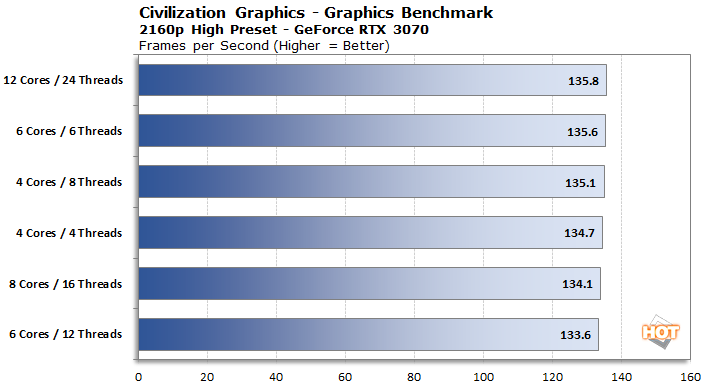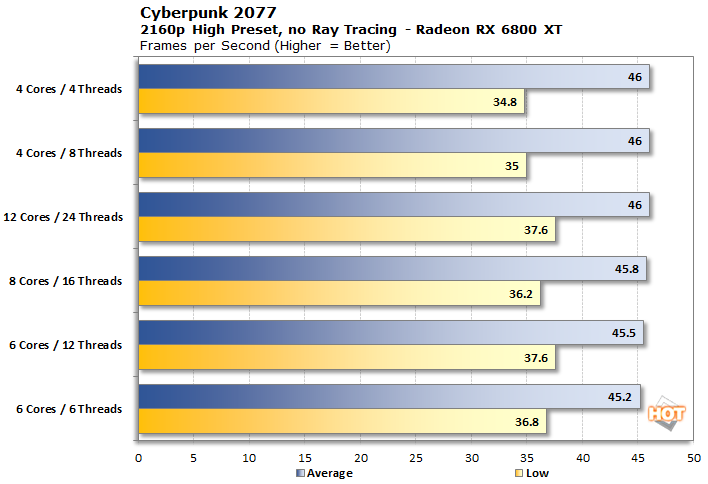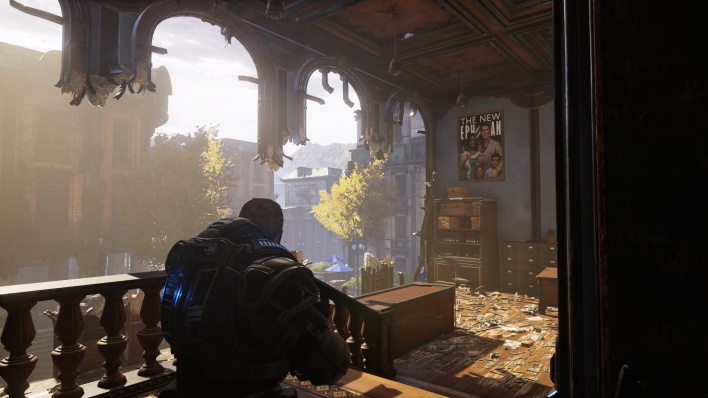How Many CPU Cores Do You Need For Great PC Gaming?
CPU Scaling At 4K, Conclusions And Our Recommendations For A Balanced Gaming PC
We were starting to hit the the GeForce RTX 3070's limit in just about every game at 1440p, and even started to make the Radeon RX 6800 XT sweat a bit in most of them at that resolution as well. We'd assumed that testing at 4K wasn't worthwhile due to the GPU becoming the bottleneck, but we wanted to prove it to ourselves. For that reason, we took our two widest deltas from the 1080p tests and ran them at UHD 4K, to see if four times the pixels really was four times the fun. We'll start with the Civ VI graphics test.


Well, we did it. We found the limits of the GeForce RTX 3070 and Radeon RX 6800 XT. Unlike the three-tiered graph from our 1080p and 1440p tests, the GeForce RTX 3070 has a single speed: 135 frames per second. It doesn't matter if you have a lowly quad core with no SMT or a big, beefy 24-threaded monster, this graphics card has found its limit. It's still pretty fast and will look amazing if you can afford a 120 Hz 4K display. But if you can do that, surely you can buy a more powerful graphics card (under normal conditions, anyway).
The Radeon RX 6800 XT has two speeds. The quad core configurations hit around 170 fps, which is pretty dang fast, but beyond that the six and up category all broke 190 fps. That means that at 4K, a budget CPU still couldn't max out a graphics card, at least in this one test.
Our other test is Cyberpunk 2077, and we expect more of the same here. A definite flattening of the curve.


Again we do see that the GeForce RTX 3070 is completely maxed out. It's amusing to see the 4C / 8T configuration take the top spot here, but that's just the way the median falls. Regardless, we don't think you'd want to play Cyberpunk at these settings and resolution, because 35 fps is console territory and not nearly as fun as 60 and up. Somewhat unsurprisingly, however, the 4C / 4T setup has the lowest bottom-end frame rate of the group. It's less than a 10% difference, but it's certainly still there and worth noting.
On the Radeon RX 6800 XT, we're again basically maxed out. A quad-core with no SMT still has the lowest of the lows, but somehow also still manages to average the same as the rest of the various setups we tested. With a FreeSync monitor, this would be alright to play, as long as the monitor's FreeSync range can handle it. Be sure to get a display with LFC (low frame rate compensation) if you're gaming at 4K, but otherwise it's not a bad experience. At least the frame rate never permanently dips below 30 fps this way.
With that out of the way, how many cores is enough for PC gaming on a 1080p high-refresh display? Many of our charts had a clear inflection point, at the same place about half-way down the chart. Four cores is definitely not enough to get the most out of today's high-end graphics cards. If your budget can't spring for a CPU with at least six cores with SMT to go with a GeForce RTX 3070 (or higher), we'd suggest re-evaluating your budget allocation. Buyers are leaving a lot of performance on the table in a large number of games if they saddle even this mid-to-high end graphics card with just four cores, even with SMT in the mix. A minimum of a six-core chip is the order of the day right now, but hold that thought for just a moment.
The value proposition is somewhat different at 1440p. The graphics card was definitely becoming a bottleneck in our GeForce RTX 3070 setup in some games. Civ VI, FarCry New Dawn, Shadow of the Tomb Raider, and Watch Dogs Legion all showed a bit of separation between the different processor configurations with the more powerful RDNA 2 GPU at 1440p, whereas the RTX 3070 was tapped out. It's no secret that a powerful graphics card is required for high-resolution gaming, especially at high refresh rates, but six cores with SMT was again just about enough to top it off. That would include the Ryzen 5 5600X and Core i5-11600K, both of which are pretty speedy processors. So, does that mean we'd recommend a six-core processor for a 1440p gaming PC?
Before we answer that, let's talk about the future and about the elephant in the room. Outside of Gears 5 and an update coming to Cyberpunk 2077, none of these games are making their way to the PlayStation 5 or Xbox Series consoles. Of course, the last console generation was saddled with much lower-end CPUs and consoles are often the target for most game developers. The PlayStation 4 and Xbox One both had eight-core processors, but those cores were based on AMD's ancient, low-power Jaguar architecture. The new console generation consisting of the PlayStation 5 and the Xbox Series X / S all have the same eight-way configuration, but with much more powerful Zen 2 cores with multi-threading. Having more powerful processors in the latest console generation means game developers have new targets and are more likely to weave in support for additional threads in their game engines moving forward.
So, let's finally answer the question: How many cores is enough to get the most out of a high-end graphics card? Today, four cores with SMT (for 8 threads) often delivers a good experience, but six cores and 12 threads is the sweet spot. Does that mean an even higher core count is a waste? We never saw a situation where a CPU with more cores/threads was ever appreciably slower. Those extra resources just weren't being fully utilized. However, we can see a day coming where some games will take advantage of 12 or more threads. Cyberpunk 2077 is a great example, as it scaled all the way up to 12 cores when the GPU wasn't a limiting factor. We see a lot more of that coming our way, now that the latest generation of consoles have support for up to 16 threads.
Ideally, if we were building a new gaming PC today, or just upgrading and keeping our current GPU due to shortages, we'd definitely want to go with eight cores at a minimum and let our collection of games grow into it. If you are more budget-constrained, however, our findings say that a modern 6-core / 12-thread processor offers plenty of performance for the vast majority of game titles.


Well, we did it. We found the limits of the GeForce RTX 3070 and Radeon RX 6800 XT. Unlike the three-tiered graph from our 1080p and 1440p tests, the GeForce RTX 3070 has a single speed: 135 frames per second. It doesn't matter if you have a lowly quad core with no SMT or a big, beefy 24-threaded monster, this graphics card has found its limit. It's still pretty fast and will look amazing if you can afford a 120 Hz 4K display. But if you can do that, surely you can buy a more powerful graphics card (under normal conditions, anyway).
The Radeon RX 6800 XT has two speeds. The quad core configurations hit around 170 fps, which is pretty dang fast, but beyond that the six and up category all broke 190 fps. That means that at 4K, a budget CPU still couldn't max out a graphics card, at least in this one test.
Our other test is Cyberpunk 2077, and we expect more of the same here. A definite flattening of the curve.


Again we do see that the GeForce RTX 3070 is completely maxed out. It's amusing to see the 4C / 8T configuration take the top spot here, but that's just the way the median falls. Regardless, we don't think you'd want to play Cyberpunk at these settings and resolution, because 35 fps is console territory and not nearly as fun as 60 and up. Somewhat unsurprisingly, however, the 4C / 4T setup has the lowest bottom-end frame rate of the group. It's less than a 10% difference, but it's certainly still there and worth noting.
On the Radeon RX 6800 XT, we're again basically maxed out. A quad-core with no SMT still has the lowest of the lows, but somehow also still manages to average the same as the rest of the various setups we tested. With a FreeSync monitor, this would be alright to play, as long as the monitor's FreeSync range can handle it. Be sure to get a display with LFC (low frame rate compensation) if you're gaming at 4K, but otherwise it's not a bad experience. At least the frame rate never permanently dips below 30 fps this way.
So How Many Cores Are Really Enough For Gaming?
Ah, the ultimate question: How many CPU cores are enough for the latest games, while not being too big of a drain on the budget? The answer to that question depends on what you're doing, obviously. However, if you're just gaming on a budget 1080p 60Hz monitor, first of all, we'd urge you to upgrade the monitor. You're missing out on a new world of higher-fidelity graphics, and you're wasting a lot of the potential of a new processor or graphics card this way. Gamers that can afford a Ryzen 5 5600X and a GeForce RTX 3070 should really spring for, at minimum, a FreeSync or G-Sync capable display with a refresh rate of 120Hz or more. Forget the nay-sayers in forums who claim we've already hit the limits of what our eyes can see at some two-digit frame rate. We know that 120Hz is worthwhile because we've seen it in action, and we think any PC gamer would want to see the same.With that out of the way, how many cores is enough for PC gaming on a 1080p high-refresh display? Many of our charts had a clear inflection point, at the same place about half-way down the chart. Four cores is definitely not enough to get the most out of today's high-end graphics cards. If your budget can't spring for a CPU with at least six cores with SMT to go with a GeForce RTX 3070 (or higher), we'd suggest re-evaluating your budget allocation. Buyers are leaving a lot of performance on the table in a large number of games if they saddle even this mid-to-high end graphics card with just four cores, even with SMT in the mix. A minimum of a six-core chip is the order of the day right now, but hold that thought for just a moment.
The value proposition is somewhat different at 1440p. The graphics card was definitely becoming a bottleneck in our GeForce RTX 3070 setup in some games. Civ VI, FarCry New Dawn, Shadow of the Tomb Raider, and Watch Dogs Legion all showed a bit of separation between the different processor configurations with the more powerful RDNA 2 GPU at 1440p, whereas the RTX 3070 was tapped out. It's no secret that a powerful graphics card is required for high-resolution gaming, especially at high refresh rates, but six cores with SMT was again just about enough to top it off. That would include the Ryzen 5 5600X and Core i5-11600K, both of which are pretty speedy processors. So, does that mean we'd recommend a six-core processor for a 1440p gaming PC?
Before we answer that, let's talk about the future and about the elephant in the room. Outside of Gears 5 and an update coming to Cyberpunk 2077, none of these games are making their way to the PlayStation 5 or Xbox Series consoles. Of course, the last console generation was saddled with much lower-end CPUs and consoles are often the target for most game developers. The PlayStation 4 and Xbox One both had eight-core processors, but those cores were based on AMD's ancient, low-power Jaguar architecture. The new console generation consisting of the PlayStation 5 and the Xbox Series X / S all have the same eight-way configuration, but with much more powerful Zen 2 cores with multi-threading. Having more powerful processors in the latest console generation means game developers have new targets and are more likely to weave in support for additional threads in their game engines moving forward.
So, let's finally answer the question: How many cores is enough to get the most out of a high-end graphics card? Today, four cores with SMT (for 8 threads) often delivers a good experience, but six cores and 12 threads is the sweet spot. Does that mean an even higher core count is a waste? We never saw a situation where a CPU with more cores/threads was ever appreciably slower. Those extra resources just weren't being fully utilized. However, we can see a day coming where some games will take advantage of 12 or more threads. Cyberpunk 2077 is a great example, as it scaled all the way up to 12 cores when the GPU wasn't a limiting factor. We see a lot more of that coming our way, now that the latest generation of consoles have support for up to 16 threads.
Ideally, if we were building a new gaming PC today, or just upgrading and keeping our current GPU due to shortages, we'd definitely want to go with eight cores at a minimum and let our collection of games grow into it. If you are more budget-constrained, however, our findings say that a modern 6-core / 12-thread processor offers plenty of performance for the vast majority of game titles.








